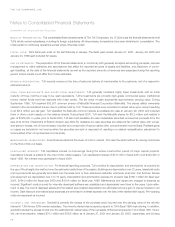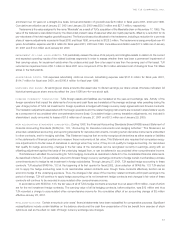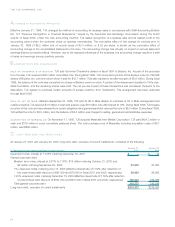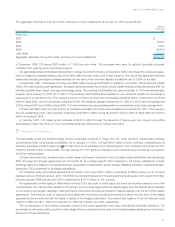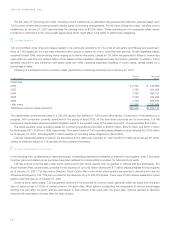TJ Maxx 2000 Annual Report Download - page 16
Download and view the complete annual report
Please find page 16 of the 2000 TJ Maxx annual report below. You can navigate through the pages in the report by either clicking on the pages listed below, or by using the keyword search tool below to find specific information within the annual report.
The projected benefit obligation and accumulated benefit obligation of TJX’s unfunded supplemental retirement plan was $23.8 million
and $18.2 million, respectively, as of January 27, 2001 and $18.6 million and $14.3 million, respectively, as of January 29, 2000. The
increase in the projected benefit obligation as of January 27, 2001 reflects actuarial losses due to a change in the assumptions regarding
mortality and a decrease in the discount rate for valuation purposes.
The portion of the net accrued liability attributable to TJX’s unfunded supplemental retirement plan amounted to $14.8 million at
January 27, 2001 and $14.0 million at January 29, 2000 and is included in other long-term liabilities on the balance sheet. The balance
of the net accrued liability is attributable to TJX’s non-contributory defined benefit retirement plan and is included in current assets as of
January 27, 2001 and in accrued expenses and other current liabilities as of January 29, 2000.
For purposes of measuring the postretirement medical plan, a 3.41% annual rate of increase in the per capita cost of covered health
care benefits was assumed and is gradually reduced to zero. The impact of medical inflation eventually diminishes because of the $3,000
per capita annual limit on medical benefits. An increase in the assumed health care cost trend rate of one percentage point for all future
years would increase the accumulated postretirement benefit obligation at January 27, 2001 by about $3,409,000 and the total of the
service cost and interest cost components of net periodic postretirement cost for fiscal 2001, by about $477,000. Similarly, decreasing
the trend rate by one percentage point for all future years would decrease the accumulated postretirement benefit obligation at January
27, 2001 by about $2,908,000 as well as the total of the service cost and interest cost components of net periodic postretirement cost
for fiscal 2001, by about $404,000.
Following are the components of net periodic benefit cost:
Pension Postretirement Medical
Fiscal Year Ended Fiscal Year Ended
January 27, January 29, January 30, January 27, January 29, January 30,
In Thousands 2001 2000 1999 2001 2000 1999
Service cost $10,734 $11,781 $10,538 $1,353 $1,366 $1,405
Interest cost 11,560 10,768 9,647 1,624 1,430 1,610
Expected return on plan assets (12,783) (11,060) (9,991) –––
Amortization of transition obligation 75 75 75 –––
Amortization of prior service cost 164 87 87 332 332 338
Recognized actuarial (gains) losses (1,085) 415 2,702 (185) –103
Net periodic benefit cost $ 8,665 $12,066 $13,058 $3,124 $3,128 $3,456
Net pension expense reflects amortization of unrecognized actuarial losses for the unfunded plan in fiscal 1999 and amortization of
unrecognized gains on the defined benefit plan in fiscal 2001. The change in assumption regarding mortality will increase the net
pension expense in future years.
During the fiscal year ended January 29, 2000, TJX and an executive officer entered into an agreement whereby the executive waived
his right to benefits under TJX’s nonqualified plan in exchange for TJX’s funding of a split–dollar life insurance policy. The exchange was
accounted for as a settlement and TJX incurred a $1.5 million settlement loss, which was primarily the recognition of a portion of the
deferred losses under the plan. During fiscal 2001, TJX entered into a similar arrangement with another executive who waived the right
to a portion of his supplemental retirement benefit in exchange for TJX’s funding of a split-dollar life insurance policy. TJX recognized a
settlement loss of $224,000 in fiscal 2001 due to this exchange. The benefit exchanges were designed so that the after–tax cash expen-
ditures by TJX on the split–dollar policies are substantially equivalent, on a present value basis, to the after–tax cash expenditures TJX
would have incurred under the nonqualified plan.
TJX also sponsors an employee savings plan under Section 401(k) of the Internal Revenue Code for all eligible U.S. employees.
Employees may contribute up to 15% of eligible pay. TJX matches employee contributions, up to 5% of eligible pay, at rates ranging
from 25% to 50% based upon the company’s performance. TJX contributed for all 401(k) plans $5.8 million in fiscal 2001, $6.2 million
in fiscal 2000 and $6.4 million in fiscal 1999.
In the fourth quarter of fiscal 1999, TJX established a nonqualified savings plan for certain U.S. employees. TJX matches employee
contributions at various rates which amounted to $163,000 in fiscal 2001, $464,000 in fiscal 2000 and $210,000 in fiscal 1999. TJX
transfers employee withholdings and the related company match to a separate trust designated to fund the future obligations. TJX
includes the trust assets in other assets on the balance sheets.
In addition to the plans described above, TJX also maintains retirement/deferred savings plans for all eligible associates at its foreign
subsidiaries. TJX contributed for these plans $1.2 million, $682,000 and $534,000 in fiscal years 2001, 2000 and 1999, respectively.
THE TJX COMPANIES, INC.
32


